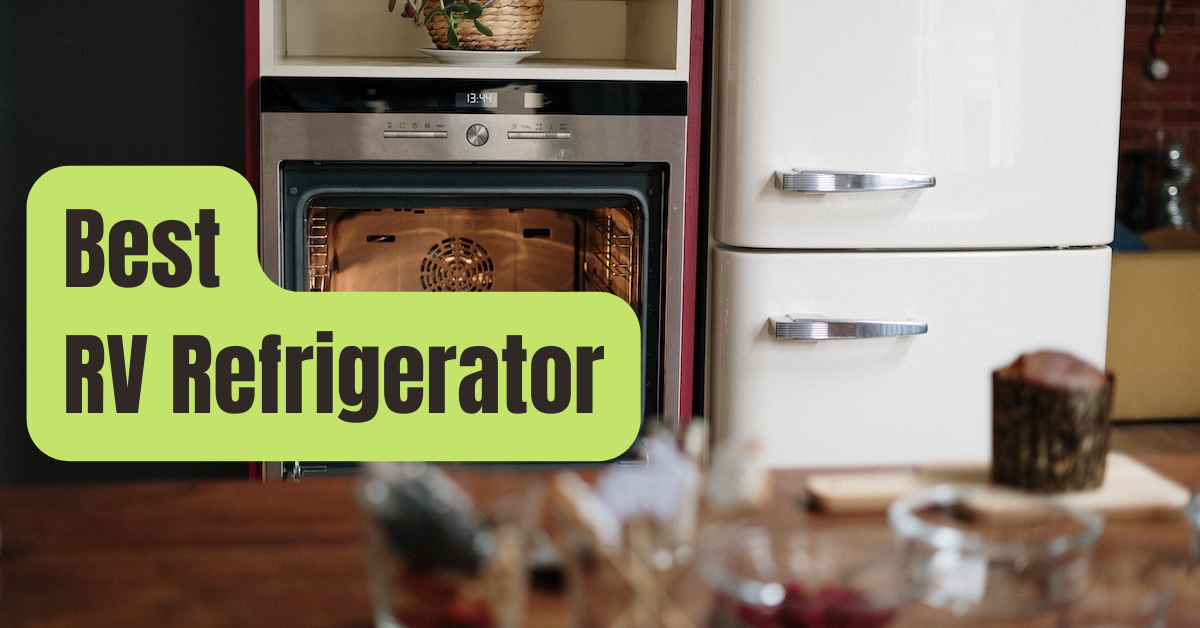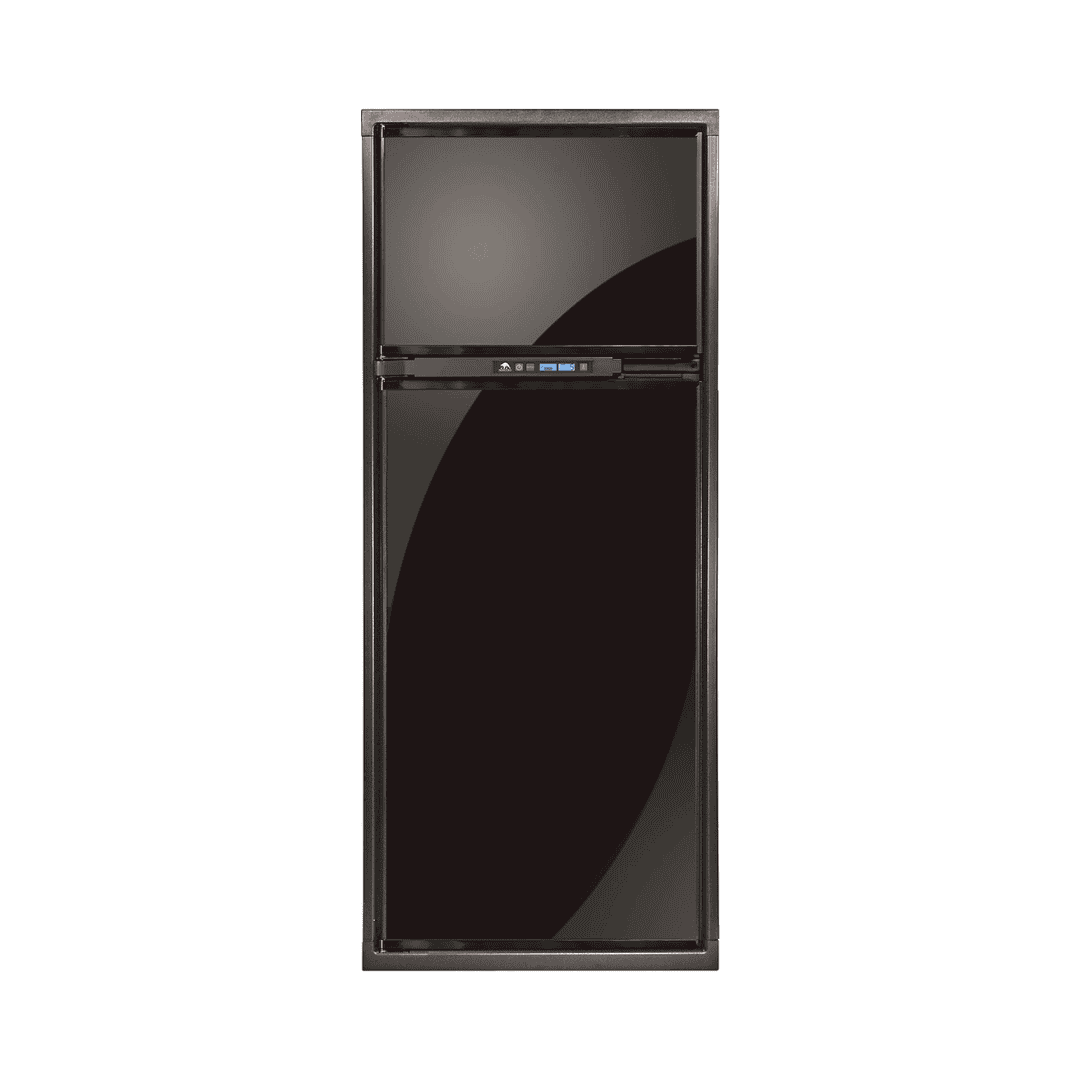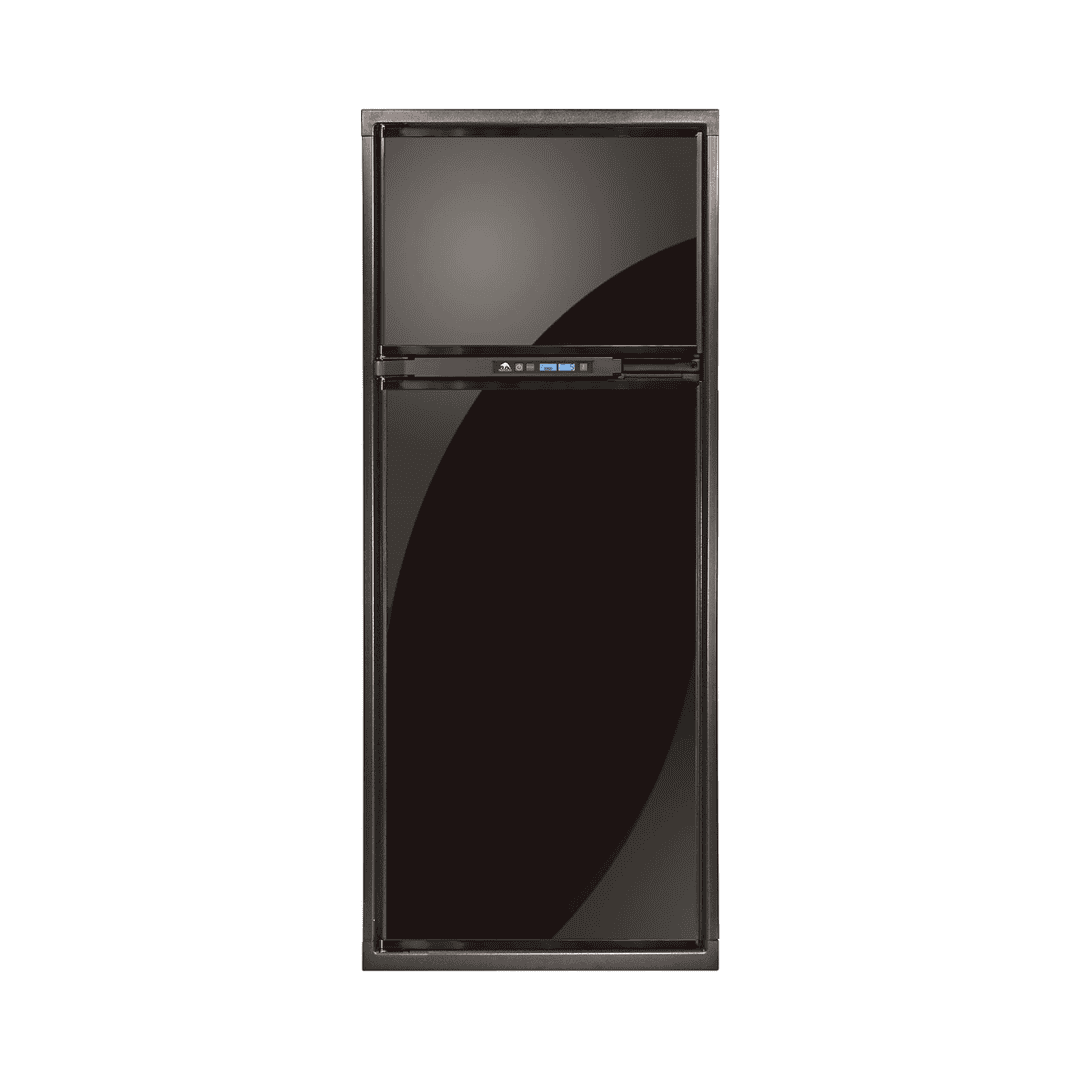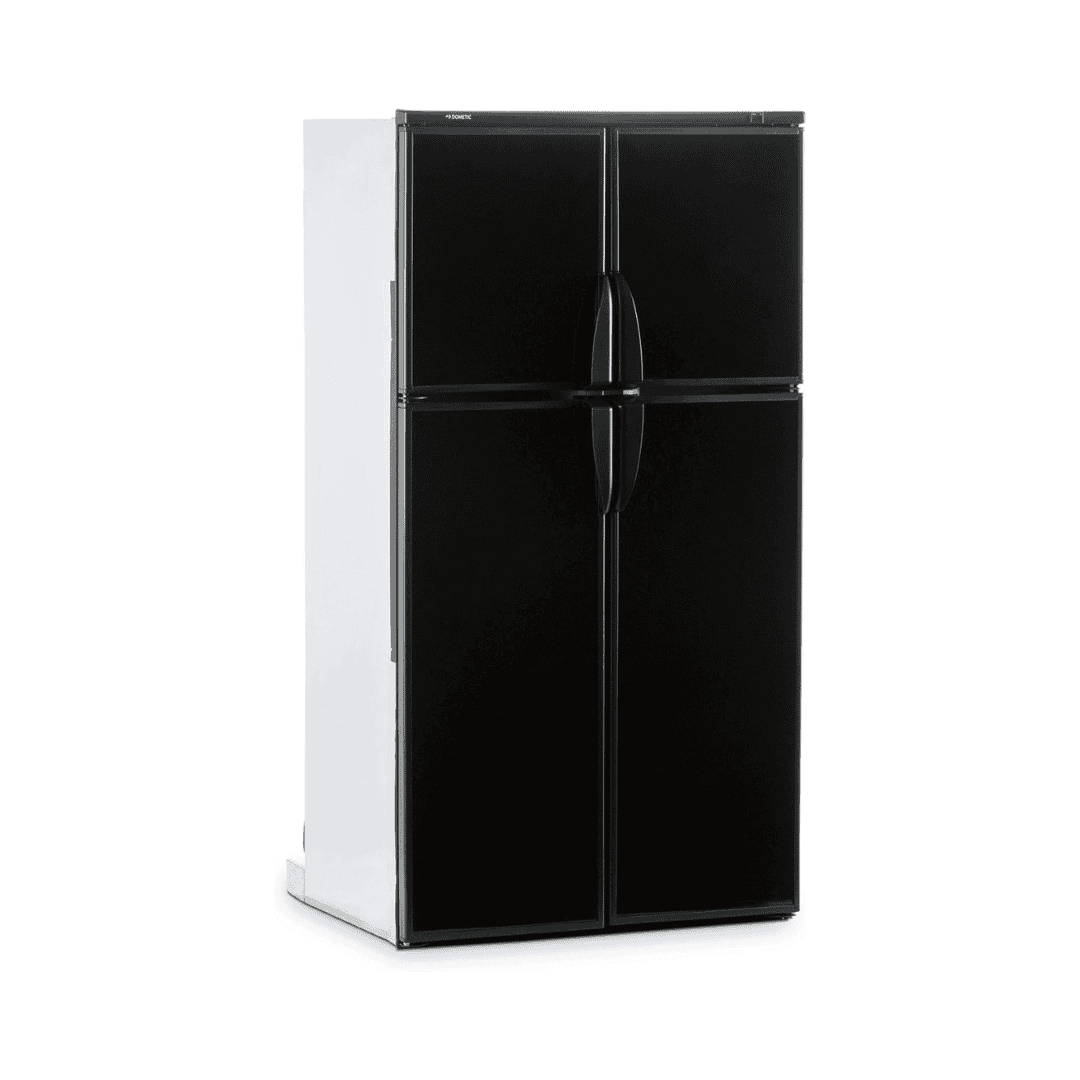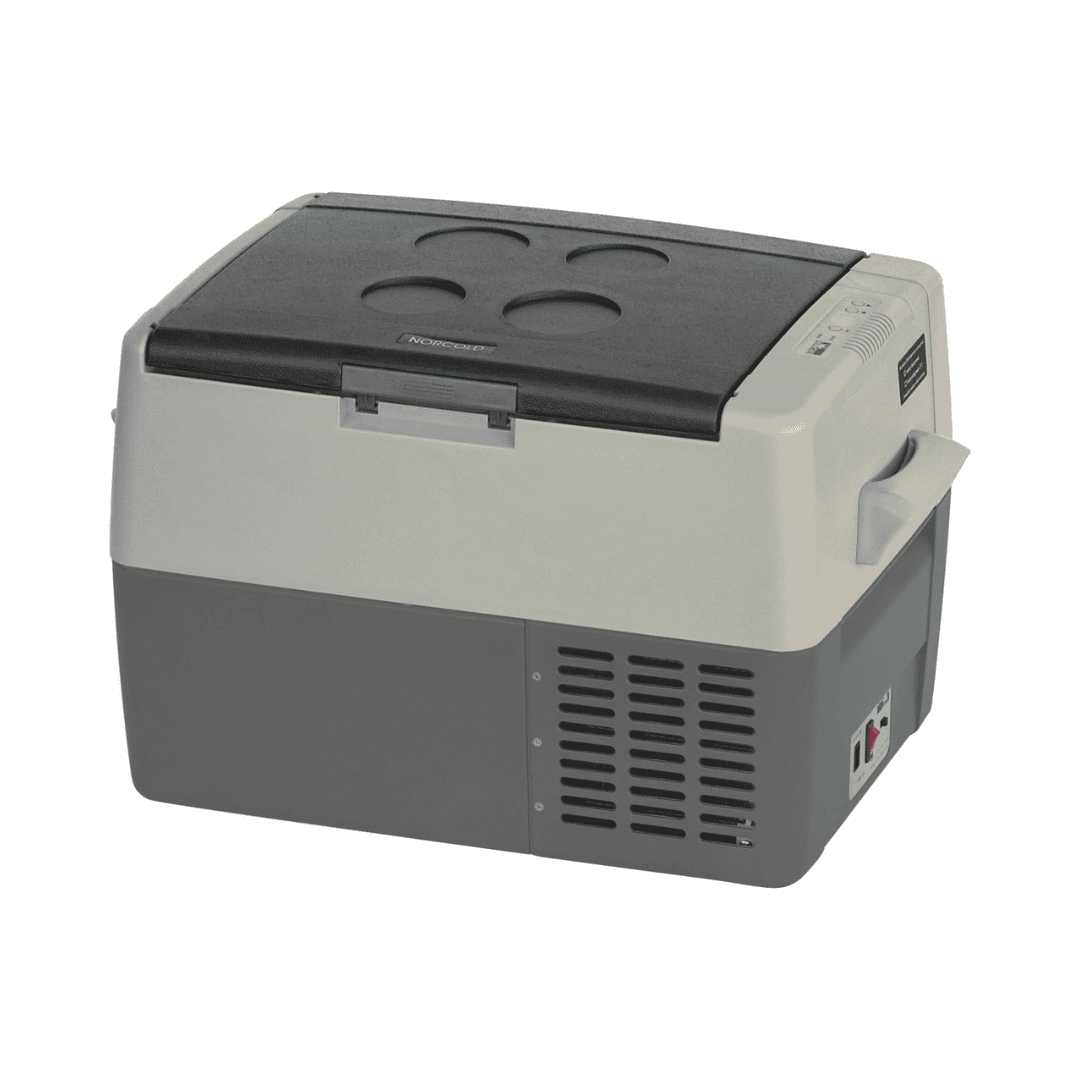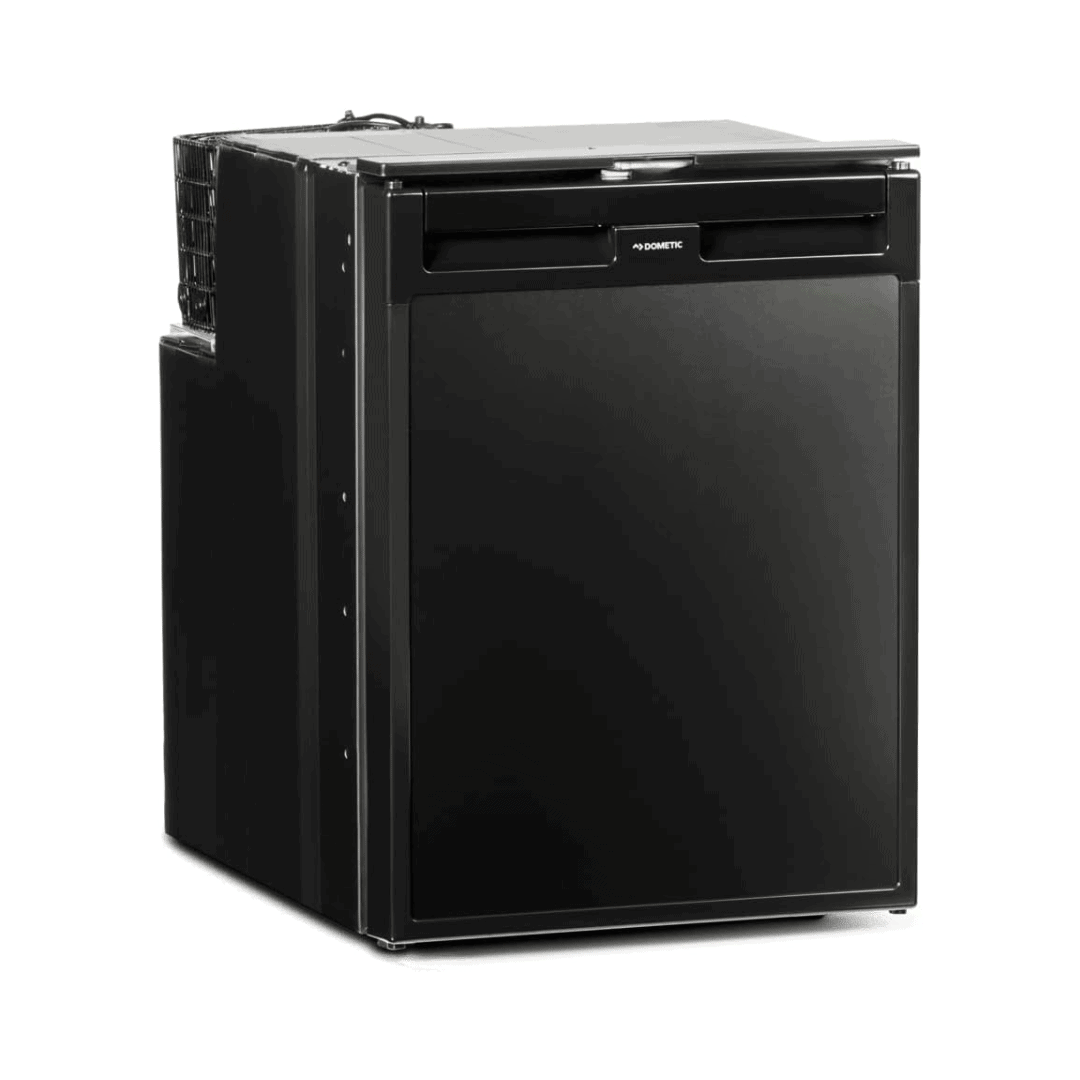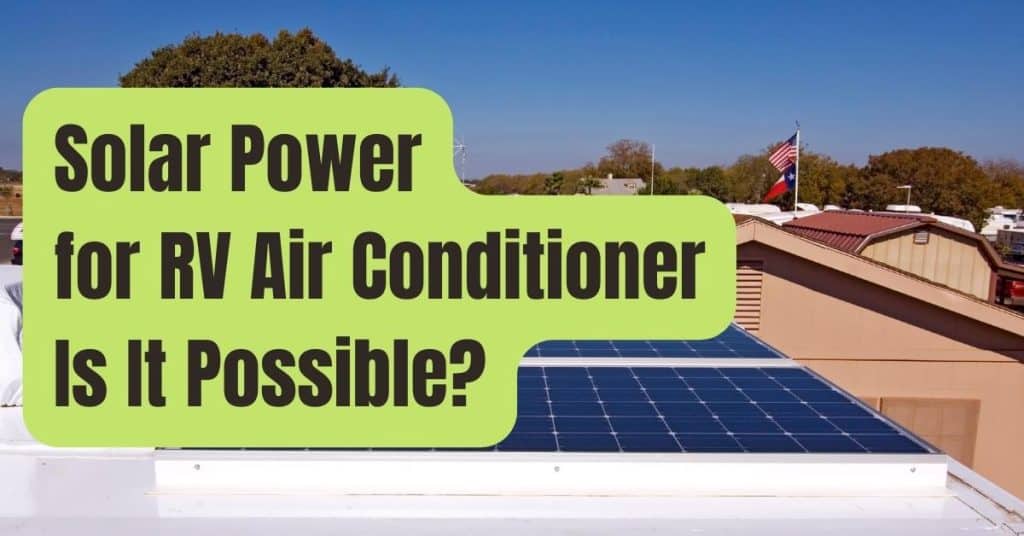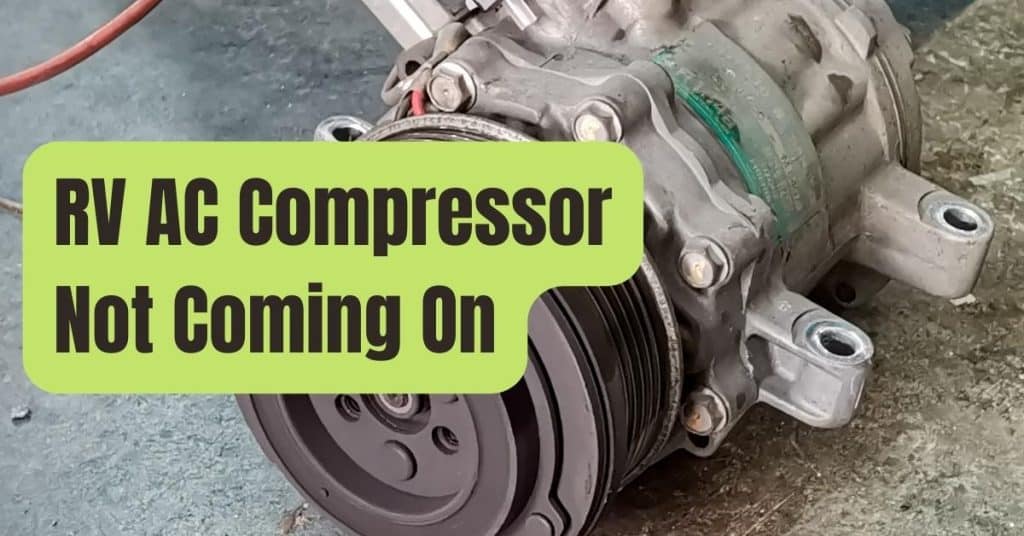One of the nicest things about camping in an RV or travel trailer is being able to keep perishable food items refrigerated.
This isn’t a perk that most tent campers or van lifers take for granted.
As a result, the refrigerator is the most often used equipment in your RV and serves as the center of your RV kitchen, allowing you to enjoy the conveniences of home while on the road.
However, if you have an older RV or are renovating one, you’ll want to improve or replace your current RV fridge with something better.
Which one, though? What should you look for in a refrigerator for a travel trailer?
Not everyone need the same features from their RV refrigerator.
Some of you may place a premium on having as much room as feasible.
Others may need an RV refrigerator that can be moved about and does not require permanent power or gas hookups.
With so many options, selecting a new refrigerator/fridge for your RV might be difficult.
So when it comes to choosing a new refrigerator, it’s all about selecting something that fits your taste, space, and price.
Fortunately, you’ve come to the right spot to discover all there is to know about the top RV refrigerators available today.
When purchasing an RV refrigerator for your motorhome or travel trailer, our Buying Guide will also assist you in prioritizing which features and specifications are most essential to you.
Find out which RV fridge freezer is ideal for you by reading on.
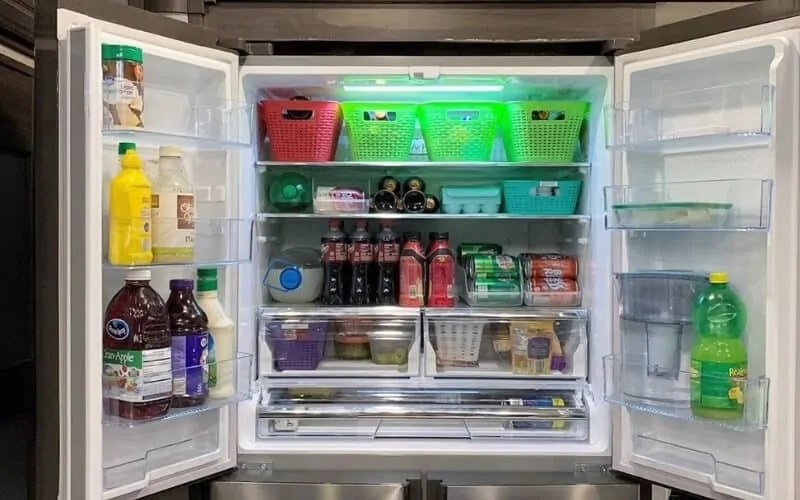
Review of the 8 Best RV Fridges and Freezers in 2025
Whether you’re searching for a 2-way, 3-way, 12-volt, or even a portable RV refrigerator, we’ve scoured the industry to assess eight of the finest options.
We’ve included the primary features and specs for each model in our evaluations, but we’ve also highlighted a few things we like and don’t like about each refrigerator so you can get a fast overview of each one.
From the refrigerator to the freezer The following are the top 8 refrigerators to purchase for your RV or camper:
- Best Overall: Dometic DM2682RB1 Right-Handed RV Refrigerator
- Best 2-Way Refrigerator: SMETA Electric 110V/Propane with Freezer RV Refrigerator
- Best 2-Way Refrigerator – Runner Up: Norcold® Polar 2-way NA8LXR Refrigerator
- Best 3-Way Refrigerator: Norcold Polar AC/LP/DC 7 cu. ft. Refrigerator
- Best 3-Way Refrigerator – Runner Up: Norcold N3104AGR 3-Way 3.7 cu. ft. Refrigerator
- Largest Compartment Capacity: DOMETIC RM1350MIM 2+2 Refrigerator
- Most Portable Camper Fridge: NORCOLD NRF30 Portable Camper Refrigerator/Freezer
- Best 12V Refrigerator: Dometic CD-50 DC only 47-Liter Refrigerator
#1. Best Overall RV Refrigerator: Dometic DM2682RB1 Right-Handed RV Refrigerator
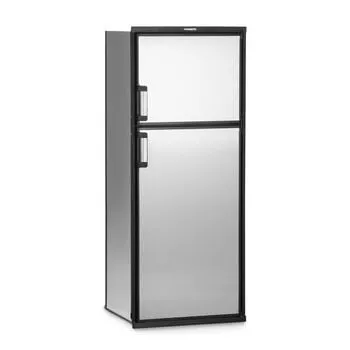
The Dometic DM2682RB1 Americana Plus Refrigerator is our pick for the finest overall design on the market today if you’re looking for an RV refrigerator that provides exceptional adaptability and durability.
This camper fridge has a total storage capacity of six cubic feet and is built with right-handed doors.
This makes it an excellent choice for RV kitchens with the refrigerator to the left of the rest of the cooking and sink area.
This refrigerator boasts a full-circle steel frame for additional durability, as well as click locks on the handles.
This means that before walking away, you have an auditory assurance that the doors are closed, which has been a problem for me in past RVs (resulting in food flying out of the fridge while driving!).
This RV refrigerator can operate on either propane gas or electricity, and it can switch between the two at the push of a button.
If you run out of one of those resources suddenly, this optimizes efficiency while simultaneously keeping the contents of your fridge cold.
You may utilize a 12-volt DC connector or a 110-volt AC outlet for the necessary electrical connection.
As a result, depending on the architecture of your RV, you have three options.
This fridge’s integrated temperature control system and LED light for internal illumination are two more features worth noticing.
The climate control system lets you to configure your preferred interior temperatures for optimal efficiency, and the LEDs burn cooler than ordinary light bulbs, so they won’t waste energy or interfere with the rest of the fridge’s cooling efforts.
Finally, the DM2682RB1 refrigerator has two crispers to keep vegetables fresh and bottle holders in the door shelves to keep smaller items secure.
All of the shelves, trays, and door bins are also adjustable and detachable.
This enables you to personalize the storage configuration of your refrigerator and makes it quite simple to clean it.
Things We Enjoy
- Versatility: You may modify your food storage plan by removing and adjusting any shelves, trays, and bins.
- Storage Capacity: The entire capacity of this refrigerator is six cubic feet.
- Click-Lock Handles: Ensure that the doors are truly closed and locked by providing audible proof.
- Energy-Efficient Lighting: The integrated LED light consumes 30% less energy than a traditional bulb.
- Three-Way Power Capability: Propane gas, 12-volt DC electricity, or 110-volt AC power may all be used to power this refrigerator.
Things We Don’t Appreciate
- Price: This isn’t the most budget-friendly RV refrigerator on our list because of its three-way power flexibility, storage arrangement versatility, and steel frame.
- Right-Handed Design: In RV kitchens, where the refrigerator is built to be located to the right of the rest of the cooking space and equipment, this may not be the best option.
#2. Best 2-Way Refrigerator: SMETA Electric 110V/Propane with Freezer RV Refrigerator
If you’re looking for a new RV refrigerator that can operate on either propane gas or 110-volt AC electricity, we recommend the SMETA SCD-185-2 Absorption Refrigerator, which comes in a variety of sizes to match various RVs.
You have the option of choosing between a smaller model with 6.1 cubic feet of internal storage space and a bigger model with 9.4 cubic feet of storage capacity.
The smaller model measures 23.6″ x 25.6″ x 57.5″ (depth, width, and height), while the bigger model is 23.6″ x 29.1″ x 64.2″ (depth, breadth, and height) (depth x width x height).
The SMETA refrigerator includes a base refrigerator storage section and an above freezer chamber.
The refrigerator has a temperature range of 32 to 50 degrees Fahrenheit, while the freezer has a temperature range of 3.2 degrees Fahrenheit.
Instead of depending on a compressor, it employs absorption technology to keep its contents cold.
This technology is very energy-efficient, silent, and ecologically benign.
It also has a longer life expectancy than compressor-based refrigerators.
If you operate it solely on propane, it burns around 1.2 pounds of gas every day.
The integrated electric/gas thermostat, on the other hand, enables you to effortlessly switch between power sources and features an indication light that indicates when the propane flame has gone out.
This is an excellent safety feature that is not seen in many other two-way refrigerators.
Another feature I enjoy about this refrigerator is the bottom-mounted single huge crisper bin.
This allows you to keep all of your fresh veggies in one handy location.
In addition, the refrigerator compartment’s shelves may be adjusted to accommodate taller beverage containers.
You may also design your perfect food storage arrangement within the fridge thanks to the flexibility.
Things We Enjoy
- Two-Way Power Adaptability: This refrigerator may be powered by propane gas or 110-volt AC electricity.
- Flame Indicator Light: If the propane pilot flame goes out for whatever reason, this device will notify you.
- Absorption Technology: Because this technology does not need a compressor, it is more efficient and quieter than compressor refrigerators.
- Long Lifespan: This refrigerator has a longer lifetime than similar RV refrigerators because to the absorption technique used to keep it cool.
- Storage Capacity: This refrigerator comes in two sizes, with storage capacities of 6.1 and 9.4 cubic feet, respectively.
Things We Don’t Appreciate
- Door Material: If not utilized correctly, the plastic door material on the outside of this refrigerator may be more vulnerable to cracks or chips.
- Control Location: The controls on this model are located at the bottom of the refrigerator unit, rather than at the top, which puts them at floor level when you need to check the status of your fridge or make any modifications.
#3. Best 2-Way Runner Up: Norcold® Polar 2-way NA8LXR Refrigerator
If there are a few aspects about the SMETA refrigerator that you don’t like, the Norcold Polar 8 LX Refrigerator is our runner-up for the finest 2-way refrigerator since it has an improved, contemporary style and boasts industry-leading storage capacity.
This refrigerator has a huge storage capacity of eight cubic feet and measures 24″ x 23.5″ x 59.875″ on the outside (depth x width x height).
This type comes with an adjustable thermostat that lets you to customize the temperature of both the freezer and refrigerator sections to your liking.
This refrigerator’s controls are also at eye level, so you won’t have to strain your neck or go down on your hands and knees to change the settings.
It also boasts outstanding seals, which prevent frost and condensation from forming on the rear wall, which is an issue with certain other RV refrigerator models.
The Norcold Polar also has a right-swing door, making it suitable for RV kitchens with the refrigerator cut-out to the right of the stove, sink, and other appliances.
There are two transparent crispers on the bottom tier for keeping fruits and vegetables separate, and the refrigerator section has a total of five shelves.
These shelves may be moved or removed as well.
As a result, this refrigerator’s storage structure can be easily customized, and shelves may be removed for simple cleaning.
Another quality of this refrigerator that I like is its elegant design.
For a more streamlined appearance, the revised design includes concealed hinges and recessed door handles.
And, from a practical standpoint, this means fewer things to bump against with your elbows or hips as you go through your RV.
Things We Enjoy
- Storage Capacity: The storage capacity of this RV refrigerator is an industry-leading eight cubic feet.
- Stylish Appearance: The sleek design of this refrigerator is enhanced by recessed door knobs and concealed hinges (and also give you less to bump into while moving about your RV).
- Dual Crispers: Fruits and vegetables have their own storage sections in these.
- Placement of Controls: This refrigerator’s controls are directly at eye level (between the freezer and refrigerator compartments). As a result, you won’t have to stoop or stand on your tiptoes to make changes to your settings.
Things We Don’t Appreciate
Price: This is a more costly RV refrigerator due to the additional storage capacity.
Weight: With a weight of 150 pounds, installing this refrigerator in your RV will need assistance.
#4. Best 3-Way Refrigerator: Norcold Polar AC/LP/DC 7 cu.ft. Refrigerator
The Norcold NA7LX.3R Refrigerator is ideal for those who desire maximum flexibility in terms of how they may power their new refrigerator.
Propane gas, a 110-volt AC power source, or a 12-volt DC connection may all be used to operate this 3-way refrigerator.
So, no matter how your RV’s electrical system is set up, you won’t have to worry about compatibility with this refrigerator.
However, you must ensure that the measurements of this refrigerator, which are 24″ x 23.5″ x 52.875″ (depth, breadth, and height), will fit in the cut-out in your RV.
However, within those dimensions, it has a storage capacity of seven cubic feet and is cold-weather capable down to 0 degrees Fahrenheit.
As a result, this is an excellent refrigerator for full-time RVers who go to cooler locations on occasion.
Personally, I like Norcold’s decision to situate the controls between the freezer and refrigerator sections on this refrigerator.
The controls are easily visible thanks to the LCD display, which maintains them at eye level.
For optimum user control, the control panel incorporates an adjustable thermostat.
Because it’s a 3-way refrigerator, you may use propane gas, 12-volt DC electricity, or a 110-volt AC power connection to power it.
The recessed door handles and concealed hinges on these Norcold freezers give them a truly clean, streamlined look.
This design aspect appeals to me as someone who has had their fair share of funny bone strikes on RV refrigerator knobs.
Also, the inside of this refrigerator has a really open feel to it.
It has two crispers, four shelves, and transparent door bins to store a lot of food.
And all of these features make it simple to view and find the products you need as soon as you open the fridge.
Things We Enjoy
- Cold Weather Capability: This refrigerator’s cold weather kit ensures that it will continue to function even if the outside temperature drops below 0 degrees Fahrenheit.
- Storage Capacity: This refrigerator has a storage capacity of seven cubic feet in a six cubic foot casing.
- Open Design: As soon as you open the fridge, you’ll be able to view and find your food products.
- Streamlined Look: You won’t run into anything when strolling around your RV if you use this refrigerator.
Things We Don’t Appreciate
- Price: While it is close in price to the other Norcold refrigerator mentioned above, it is not the most cost-effective model on our list.
- Weight: Although this model is lighter than the Norcold above at 132 pounds, it will still need two persons to lift and install inside your RV.
#5. Best 3-Way Runner Up: Norcold N3104AGR 3-Way 3.7 cu. ft. Refrigerator
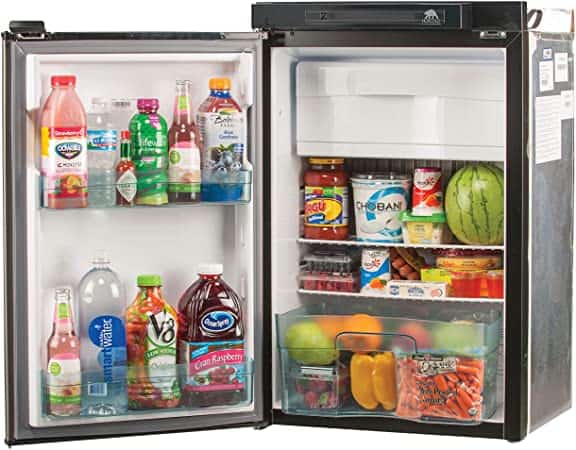
The Norcold N3104AGR Refrigerator is our runner-up for the best 3-way refrigerator because it’s one of the few small refrigerators of its size that also has a dedicated freezer section.
If you’re looking for a smaller refrigerator for use in a cab-over camper or camper van, the Norcold N3104AGR Refrigerator is our runner-up for the best 3-way refrigerator because it’s one of the few small refrigerators of its size that also has a dedicated
It’s also unusual for such a compact refrigerator to be so flexible to several power sources.
This refrigerator, however, may be powered by propane gas, a 12-volt DC power source, or a 110-volt AC connection.
This gives the fridge a lot of flexibility, allowing it to work with a wide range of RVs.
Adjustable food fences connect to the shelves to protect your food from slipping out while you’re driving.
This reduces the risk of food falling out of your refrigerator as soon as you open the door.
Another feature of this refrigerator that I enjoy is the automated power source selection.
This enables it to pick between your gas and electric connections automatically, so you don’t have to bother about double-checking it.
Things We Enjoy
- Price: This fridge is less expensive than the other two Norcold models listed, maybe due to its lower size.
- Power Versatility: This refrigerator may be powered by AC, DC, or propane gas.
- Dedicated Freezer Section: This enables you to keep a limited quantity of frozen goods in your refrigerator, which is unusual for a refrigerator of this size.
- Adjustable Food Fences: Food won’t fall off the shelves while you’re driving with these on.
Things We Don’t Appreciate
- Storage Capacity: Because it only has a storage capacity of 3.7 cubic feet, this refrigerator is best suited for compact RVs or camper vans.
- Left Swing Door: This refrigerator works well in kitchens with a layout that places the refrigerator to the left of the stove, sink, and other appliances.
#6. Largest Compartment Capacity: DOMETIC RM1350MIM 2+2 Refrigerator
If you’re looking for an RV refrigerator with the most compartment capacity, the Dometic RM1350MIM Refrigerator is a good choice.
The outside measurements of this type are 63.16″ x 32.34″ x 26.16″ and it has a storage capacity of 13.5 cubic feet (height x width x depth).
This Dometic refrigerator is a four-door type with a side-by-side design.
All of the doors open in opposing directions, swinging out and away from each other.
If you want to assure access to all of your food, you’ll need to place this refrigerator in a spot where the doors can swing open both directions.
This refrigerator has an ice maker in one of the top freezer compartments, while the other has a divider-free design that provides superior wall-to-wall chilling than other two-door refrigerators.
The doors include an optional automatic locking mechanism that securely closes the fridge and freezer doors when your RV’s ignition is switched on, and the whole model has a very robust build.
This keeps you safe from spills and messes that might happen if the doors open by mistake while you’re driving.
Through-the-door water is another optional feature available with this refrigerator.
So you can make it seem like home when traveling in hotter locations and still enjoy chilly water.
The final feature of this Dometic refrigerator that I want to highlight is its concealed digital display.
This display is located at the top of the refrigerator and can only be reached by opening one of the freezer compartments.
This still allows for plenty of user control, but it does away with the obnoxious tiny green light that may keep your visitors awake when sleeping on your RV’s pull-out couch bed.
Things We Enjoy
- Storage Capacity: The inner storage capacity of this double-door refrigerator is 13.5 cubic feet.
- Ice Maker Included: This is a unique feature among RV refrigerators, but if you install it, you’ll be able to add ice to your drinks without having to purchase it in a bag.
- Automatic Locking System: This is an optional function, but when you start your RV engine, it will automatically lock your refrigerator and freezer doors.
- Through-The-Door Water: This refrigerator may make your RV kitchen seem more like a home by providing cold water via the refrigerator door.
Things We Don’t Appreciate
- Overall Size: This refrigerator will need a relatively big cut-out (63.16″ x 32.34″ x 26.16″). As a result, it may not be suitable for smaller RVs.
- Price: This is without a doubt the priciest RV refrigerator on our list.
- Weight: This refrigerator weights about 250 pounds, as you would expect given its size. As a result, it may take three persons to get this model inside your rig and install it.
#7. Most Portable Camper Fridge: NORCOLD NRF30 Portable 1.1 cu. ft. Camper Refrigerator/Freezer
The Norcold NRF30 Portable Refrigerator, with dimensions of 22″ x 15.7″ x 15.6,” is the most portable camper fridge for a tiny RV, cab-over camper, or even vehicle camping (length x width x height).
Despite this, it has a storage capacity of 1.1 cubic feet and can be powered by the provided DC power connection, which can be connected into a conventional cigarette lighter.
If you wish to connect this fridge into a 110-volt AC outlet, there is an AC power adaptor available.
Despite its modest size, this model has a two-in-one feature that allows it to be used as a refrigerator or a freezer.
Whether you’re merely keeping beer cool or need to keep meat or veggies frozen, the electronic control panel makes it simple to adjust your desired internal temperature.
This refrigerator is also composed of tough, corrosion-resistant plastic, ensuring that it will withstand the rigors of RV or truck camping.
This is significant because unlike a typical RV refrigerator, it will not be attached or anchored to the frame of your RV.
This refrigerator’s handles are likewise heavy-duty to withstand huge loads, and you can remove them if they get in the way wherever you put it in your rig.
The hinged top is detachable and reversible as well, with four little slots for beverage holders on one side.
The detachable wire basket inside this portable refrigerator makes it easy to keep your cold stuff organized.
When you need to clean the inside of the refrigerator, this basket can simply be removed.
To keep its contents cool, this refrigerator uses a hermetically sealed compressor.
It is, however, made with CFC-free insulating foam and has built-in low voltage protection to prevent harm to its electrical components.
Things We Enjoy
- Runs Off Your Cigarette Lighter: The cigarette lighter in your RV, truck, or automobile may be used to power this refrigerator.
- AC Adapter Available: However, an AC adapter may be purchased to allow you to use an AC outlet to power this refrigerator.
- Corrosion-Proof Design: You won’t have to worry about this refrigerator rusting over time, which is both unattractive and harmful.
- Stainless Steel Interior: Because this refrigerator is unlikely to be bolted or screwed into your RV like other of the more common RV refrigerator types, it helps to maintain its safety and security.
Things We Don’t Appreciate
- Storage Capacity: With approximately 1.1 cubic feet of storage space, this refrigerator is ideal for weekend excursions or brief getaways.
- Security: You’ll have to be creative when it comes to keeping this refrigerator safe and in position in your RV since it won’t be fastened or screwed into the frame.
#8. Best 12V Refrigerator: Dometic CD-50 DC only 47-Liter Refrigerator
If you know that the cut-out where your new refrigerator will be put only has a 12-volt DC electrical connection, we propose the Dometic CD-50 Drawer Refrigerator.
This is a compact refrigerator that works well in shorter RVs, cab-over campers, trucks, or camper vans.
Its dimensions are 19.7″ x 21.3″ x 15″ and it has a total storage capacity of 1.65 cubic feet (height x width x depth).
This refrigerator’s cooling system is based on a completely hermetically sealed compressor with integrated control electronics that enable you to adjust the interior temperature to your preference.
The whole drawer pulls out from the refrigerator’s housing, making it a one-of-a-kind design.
As a result, rather than having a door swing open, it provides access from the top, which might be useful in a camper van or cab-over with limited room.
The drawer is supported by roller bearing slides, making it simple to open.
When driving, however, the top handle keeps it safe, and you may also use the supplied keyed lock to protect the contents of this refrigerator.
Things We Enjoy
- Integrated Control Electronics: Allow you to adjust the thermostat to maintain the desired interior temperature.
- Slide Drawer Style: The whole drawer slides open from the top for convenient access (great for tiny setups!).
- Security: This refrigerator is secured with a keyless lock that opens and closes with a single motion.
- Roller Bearing Slides: The whole drawer is supported by these slides, making it very simple to open and shut.
Things We Don’t Appreciate
- Storage Capacity: This fridge only has 1.65 cubic feet of storage capacity, making it ideal for smaller rigs or shorter journeys.
- DC Only: This refrigerator can’t be powered by propane gas or an AC connection, thus it’s preferable if your rig can only feed it with DC power.
In 2025, Here Is A Buying Guide For The Finest RV Refrigerator.
Now that you’ve seen a variety of refrigerator models, it’s time to start reducing down your choices.
We’ll help you select the most critical features and specs for you and your RV in our Buying Guide!
Types of Refrigerators for RVs
There are many different kinds of RV refrigerators to select from.
Let’s begin by identifying these categories and addressing some of their key benefits and downsides.
#1. Refrigerators That Run On Electricity
Only an AC or DC power source may be used to power an electric refrigerator.
A 110-volt or 120-volt AC power source is preferred by most electric RV refrigerators, however others require a 12-volt DC connection.
While these refrigerators may be incredibly efficient, they depend on your capacity to store additional power through your RV’s internal battery bank or your connection to a power stand.
#2. Refrigerators That Run On Propane
There are a few RV freezers that are built to run on propane gas, albeit they are uncommon.
While propane gas is quite inexpensive, the main disadvantage of this kind of refrigerator is that it has no backup power source in the event that you neglect to check your propane supply and run out suddenly.
#3. Refrigerators With Two Doors
The two-way feature of these freezers refers to the power sources that they will use.
Two-way RV refrigerators may be powered by either propane gas or a 110-volt AC power source.
Depending on your preferences or the availability of propane or electricity, they may effortlessly switch between these two power sources.
#4. Refrigerators With Three Doors
Three-way refrigerators may be powered by either a 110-volt AC or a propane gas hookup.
They also allow you to connect them to a 12-volt DC power source, which you may get straight from your RV battery or from a separate battery linked to solar panels.
#5. Coolboxes Using Thermoelectric Technology
Another kind of RV refrigerator used in smaller RVs and camper vans is the thermoelectric coolbox.
These refrigerators take up the least amount of room of all the refrigerator kinds, and they are also the most cost-effective.
They do a good job of keeping their contents cold, but they don’t come with a freezer section.
Another disadvantage of these coolboxes is that they don’t work as effectively on excessively hot days.
So, in the heat of summer, you can open your refrigerator to discover its contents less-than-cold, which is never ideal.
#6. Refrigerators with Compressors
Refrigerators with compressors are more popular in homes than in RVs.
They do, however, depend on compressor technology, which constricts refrigerant vapor, elevates its pressure, and pushes it up through the coils in the fridge’s rear.
When the vapor rises and comes into contact with colder air, it condenses into a liquid form at high pressure and cools.
It then returns to the coils within the freezer and refrigerator regions.
As it does so, it absorbs heat from inside the fridge, lowering the temperature within.
Finally, the refrigerant condenses and flows back into the compressor as a gas.
Then the process starts all over again.
Size
The size of a refrigerator determines whether it will fit in your RV without requiring extensive frame modifications.
In this case, we’re explicitly discussing the external dimensions of the RV refrigerators in question.
If you’re merely replacing an old RV refrigerator, you’ll most likely need to match the specifications of your new refrigerator to the precise measurements of the refrigerator you’re replacing.
This is, of course, unless you also want to remove some cabinets and renovate a bigger portion of your RV’s kitchen.
Those who are entirely repairing or refurbishing an older RV (or converting an old van or bus to an RV) may, on the other hand, have greater flexibility in selecting a bigger or smaller RV refrigerator.
In this situation, you may want to design your kitchen arrangement around the size of your RV.
If you choose with the latter option, the capacity of the refrigerator will be the most important factor to consider (which we’ll go over in the following section).
And after you’ve found a refrigerator with the capacity you need, you’ll be able to look at its external measurements and design your kitchen makeover around them.
Capacity
Size and capacity are not the same thing.
It has less to do with how much room your refrigerator takes up and more to do with how much space your refrigerator takes up inside.
The capacity of most RV refrigerators is measured in cubic feet.
This figure is based on the amount of internal space in the refrigerator.
One cubic foot is about the size of a basketball as a useful visual reference.
So, if you want to keep your three favorite basketballs cool in your RV refrigerator, you’ll need one with a three-cubic-foot capacity.
However, if you choose the size of a six-foot-tall basketball, you’ll need to increase your desired capacity to around six cubic feet.
Layout of Storage
However, you should consider the internal architecture of a refrigerator in addition to its capacity.
Three huge shelves, two bins, and four additional little shelves in the door aren’t standard on all RV refrigerators.
There are a variety of layouts available, such as one-door and two-door refrigerators, which alter how you access the storage capacity.
In the end, your decision on this point will mostly be a question of personal taste.
If you want to have a lot of frozen foods or berries on hand for smoothies or ready-to-eat meals, for example, you’ll want a storage plan that favors freezer space above fridge capacity.
Those who arrange their RV trips around the locations and hours of their favorite farmer’s markets, on the other hand, may need a storage layout with more than simply two humidity-controlled vegetable storage containers.
These are only two instances of how various people would choose different storage configurations.
But I think it demonstrates why you should focus on how a refrigerator’s inner storage space is organized rather than the ‘cubic foot’ figure that indicates its total storage capacity.
Power Requirements
You’ll also need to examine the power requirements for any RV refrigerator you want to install.
For our money, you should choose for a device that can operate on both propane and electricity, if at all feasible.
This gives you options if you run out of propane or if you’re going off-grid for days at a time and want to save power.
However, in addition to selecting a refrigerator that can operate on either electricity or propane gas, you’ll need to examine the sort of electric current that a refrigerator requires to function properly.
Alternating current or direct current may be used.
Furthermore, various freezers may need different voltage inputs.
Most RV batteries, for example, provide a 12-volt direct current that must be inverted to alternating current before any equipment requiring AC power can operate.
Thankfully, most RVs come with a built-in DC-to-AC converter.
If yours doesn’t, and the refrigerator you buy demands alternating current, you may find yourself fiddling with the internal electrical system of your RV more than you expected.
Durability
The material used to construct an RV refrigerator has a significant impact on its long-term durability.
Fortunately, most freezers touted for RV usage are designed to withstand the movement, bouncing, and vibrations that they may encounter while on the road.
As a result, you should be sure to read customer reviews for any RV refrigerator you’re contemplating.
These user evaluations are the ideal place to go for information that you won’t find anywhere on the web.
They’re also where you’ll discover complaints about any refrigerator that isn’t built to last.
If, for example, parts of a refrigerator’s doors, bins, trays, or hinges don’t stand up to the rigors of RV usage, it will usually become apparent after a month or two of use.
Check a number of consumer websites that offer RV items, including (but not limited to) Amazon, Camping World, and Wal-Mart, for the most up-to-date reviews on RV refrigerators and their durability.
Price
These refrigerators aren’t always the most cost-effective equipment to replace in your RV.
However, if you want to keep perishable foods fresh while traveling in an RV, they are a must-have.
So, Which Is The Most Appropriate For You?
The Dometic 2682RB1 American Plus Refrigerator is the obvious winner for finest overall RV refrigerator because of its remarkable adaptability and durability.
It’s one of the few refrigerators on our list with a full-circumference steel frame to protect the inside components.
This refrigerator is also a clear winner for best overall since it features six cubic feet of storage capacity and click-lock handles to ensure that the doors are constantly shut.
That function is essential to me as someone who has had their refrigerator doors open while driving down the road (imagine the mess!).
However, if you’re looking for a more portable solution for truck camping or a compact camper van, the Norcold NRF30 Portable Refrigerator is a good choice.
This is the ideal choice for tiny setups since it takes up little room (22″ x 15.7″ x 15.6″) and plugs directly into the cigarette lighter.
It still has a practical storage capacity of 1.1 cubic feet and may be programmed to your preferred temperature.
This means you may use it to chill a few drinks or turn it down to keep meats and veggies frozen.
FAQs
The truth is that selecting an RV refrigerator is only one of several options for dealing with this important RV item.
As a result, we’ll try to address some commonly asked questions regarding RV refrigerators by providing further information on how to install, care for, and clean an RV refrigerator.
What’s the deal with these RV refrigerators?
While RV refrigerators perform the same functions as home refrigerators, they do so without the need of a compressor or any mechanical components.
Because of the vibrations that an RV encounters when traveling, moving components are more prone to damage or malfunction.
Instead, RV refrigerators heat the exact kind of refrigerant they hold using propane or electricity.
In reality, the majority of the top RV refrigerator models can run on either propane or electricity.
This allows them to keep your perishable stuff cold even when your RV isn’t hooked into a power outlet.
What are some helpful hints for keeping an RV refrigerator in good working order?
The majority of RV refrigerators are built to perform best when your RV is level.
One of the easiest methods to keep your refrigerator in good working order is to level your trailer whenever you park in a new campground or storage facility.
Furthermore, it’s a good idea to position your truck so that the side where your refrigerator is placed doesn’t get much direct sunshine during the day.
If you’re RVing in the Northern Hemisphere, for example, try to position your RV such that the side where your refrigerator is placed is always facing north.
Additionally, some RV owners swear by the value of adding a little “muffin fan” inside your refrigerator.
These fans aid in the circulation of cold air throughout the refrigerator and freezer, increasing the refrigerator’s overall efficiency.
Finally, to avoid the growth of mold or mildew, be sure to clean your RV refrigerator on a regular basis.
It’s also a good idea to switch off the electricity to your fridge and leave the fridge and freezer doors open to enable it to dry out if your RV is sitting unused for weeks at a time.
This minimizes the amount of energy your RV uses while it’s in storage, as well as the possibility of mold or mildew forming in your refrigerator.
Is it possible to put a conventional refrigerator in my RV?
In a nutshell, the answer is no! Regular freezers are built of weaker metals that aren’t strong enough to survive the bounces and vibrations that come with RV living.
If you put one of these fridges in an RV, it’s likely to fail or malfunction, and most of them aren’t compatible with DC electricity or propane gas.
When it comes to RV refrigerators, how long do they last?
The majority of RV refrigerators are built to last as long as the RV or travel trailer in which they’re installed.
Regrettably, this does not always prove to be the case.
Most RV refrigerators, on the other hand, will survive between 10 and 15 years on average.
So, if your RV refrigerator is considerably older than that, there’s even more incentive to look into the options we’ve discussed above!
How do you replace a refrigerator in an RV?
After you’ve found and bought a new RV refrigerator, it’s time to get rid of the old one to create way for the new.
While the procedure isn’t extremely complicated, it does need doing the stages in the correct sequence, particularly because we’re dealing with an appliance that’s likely to be powered by both electricity and propane gas.
To begin, switch off your current refrigerator to ensure that it is not receiving electricity.
Switch off the propane tank and make sure your RV’s motor isn’t running at this point.
The next step is to locate the access panel that goes to the refrigerator’s rear. This is usually on the exterior of your RV, on the other side of your trailer from the fridge.
The connections for electricity and gas to your refrigerator are located within this panel.
Start by removing the cables that provide electric power to your refrigerator once you have access to these connections.
The propane line may then be disconnected, which may involve the use of a wrench or a pipe clamp.
When unscrewing your gas line, though, be cautious not to force anything since you’ll need it to connect to your new refrigerator.
You may return inside after disconnecting the power and gas to your refrigerator. After that, you’ll need to figure out which screws are keeping the refrigerator in place.
Most RV refrigerators have at least four screws holding them in place, but others have many more. Locate and remove these screws, and your refrigerator should now be free of your RV.
Finally, you’re ready to remove the refrigerator from your RV, travel trailer, or 5th wheel by lifting it.
However, some of these older refrigerator models are extremely hefty, so locate a companion to assist you in lifting and carrying your fridge out of your rig.
You may now install your new RV refrigerator by going through the instructions in reverse order. When you get to that stage, though, be sure the propane line is firmly attached.
It’s also a good idea to verify that connection before reopening the propane tank and turning on your refrigerator.
If you smell gas or hear a hissing noise at your refrigerator’s access panel after opening the propane tank, shut it immediately and review the propane connection’s security.
How do I clean the refrigerator in my RV?
When you return from a camping vacation, the ideal time to clean your RV refrigerator is just after you get home.
And the simplest way to do it is to empty the fridge and freezer of all food products so that nothing gets in your way.
If your refrigerator includes detachable bins or trays, removing them completely is the quickest method to clean them.
You may also just spray them off outdoors. However, you may need to scrape any caked-on residue off with a sponge before spraying them clean.
Also, before putting these bins or trays back in the fridge, ensure sure they are fully dry.
Return inside with a cloth and some multi-purpose cleanser while your bins or trays are drying.
Wipe the refrigerator from top to bottom to ensure that any stray crumbs fall to the bottom.
You can even vacuum up stray crumbs before wiping clean the whole fridge if you have a vacuum.
Alternatively, if you intend on sweeping or vacuuming your RV’s flooring after cleaning your refrigerator, just wipe dirt onto the floor and vacuum or sweep it up in the next part of your post-trip cleaning routine.
Conclusion
Your RV refrigerator, in my experience, is one of those things that you’ll neglect until it breaks out.
When you open your refrigerator and see that it’s over 60 degrees inside, it’s always a stomach hit.
And although there are a variety of reasons for this sort of problem, having one of the top RV refrigerator alternatives can lessen the chances of your fridge breaking down.
These RV refrigerator alternatives are the finest choices for enhancing your perishable food storage in your RV whether your RV is older or you’re merely changing the inside appliances.
We hope you found these evaluations and our recommendations for the best RV refrigerator useful.
We also wish you success in selecting and installing your new RV refrigerator!

